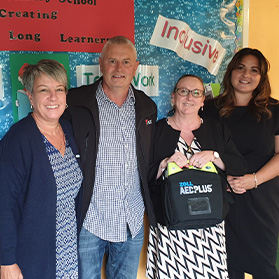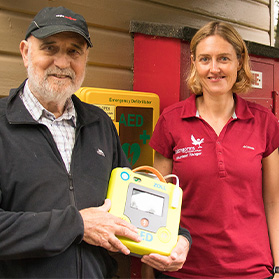Anything can happen. Anyone can help.

Imagine that you're waiting in a queue at the shop when the woman standing in front of you suddenly falls to the floor. Alarmed, you exchange looks with the sales assistant, who yells for someone to call emergency services. You, along with the other bystanders in the queue, are inwardly hoping that someone else will step forward to help. But because you are standing next to the victim, you try to help. "Are you ok? Miss! Are you ok?" You shake her shoulder, quickly realizing the gravity of the situation as you get no response. So you stay by her side and wait, desperately hoping that help arrives quickly.
With just a bit of planning, we can all be ready to do more than simply wait and hope.
Anything can happen
Events like this occur every day, in all types of places and to people of all ages: A teenager suffers sudden cardiac arrest (SCA) during football practice. A man suddenly collapses at the gym. A colleague becomes unresponsive and stops breathing.
- In Europe each year, it's estimated there are more than 350,000 incidents — almost 1,000 per day — of out-of-hospital cardiac arrest (OHCA).1 Nearly 90% of OHCA victims don't survive.
- Without intervention, an SCA victim's chance of survival decreases by 10% every minute.
- In any medical incident, contacting emergency medical services (EMS) immediately is a critical first step, but it may take 7 to 18 minutes for them to arrive.2
- Providing chest compressions immediately and prior to the arrival of paramedics could save 100,000 lives.1

Anyone can help
When organisations are prepared with the right equipment and bystanders have the confidence to step in, anyone can help provide care when time is of the essence. And that preparation requires only a few simple steps.
Every SCA rescue really begins well in advance of an incident — when a business owner, health and safety manager, facility manager or school nurse demonstrates a commitment to safety by purchasing and installing AEDs and implementing a response plan.
More than just equipment installation, a response plan incorporates support and programme management services that ensure equipment is maintained and consumables are up to date. It also integrates CPR and AED training, giving individuals the confidence to step in when there's a call for help.
And data shows that outcomes improve when they do. SCA victims who receive CPR and defibrillation show up to a 60% survival rate.
Read about real people who stepped in to help quickly and confidently while waiting for EMS to arrive:



Most of the bystanders in these stories had no professional medical training and most had never used an AED before. All later remarked how easy the rescue equipment was to use and how clear the instructions were, despite the stress of a medical emergency. With guidance and feedback from an AED, rescuers knew they were taking the appropriate steps and performing them correctly and effectively.
Hope is in your hands
Let's go back to that woman queueing at the shop. Wouldn't you feel confident knowing you've taken steps to reduce uncertainty, encourage bystander intervention and ensure your workplace is prepared when every minute counts? By empowering people with AEDs, programme management and training, anyone can help save a life.
Learn the steps you can take to develop and implement an emergency response plan, install AEDs and provide adequate programme management support.
You can ensure employees and those who visit your organisation will be ready for anything to happen and for anyone to help.
1 European Registry of Cardiac Arrest - Study TWO (EuReCa TWO), European Resuscitation Council website, www.erc.edu/projects/eureca-two. Accessed 3 Jan 2023.
2 www.england.nhs.uk/wp-content/uploads/2017/07/new-ambulance-standards-easy-read.pdf. Accessed 3 Jan 2023.
